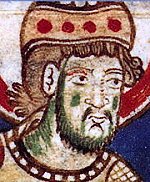
Back Pous Damasus I Afrikaans Damasus I. ALS داماسوس الأول Arabic القديس داماسوس ARZ Dámasu I AST Дамасій I Byelorussian Дамас I (папа рымскі) BE-X-OLD Дамас I Bulgarian Damasus Iañ Breton Damas I Catalan
Damasus I | |
|---|---|
| Bishop of Rome | |
 Damasus I depicted in a c. 4th century miniature | |
| Church | Catholic Church |
| Papacy began | 1 October 366 |
| Papacy ended | 11 December 384 |
| Predecessor | Liberius |
| Successor | Siricius |
| Personal details | |
| Born | c. 305 Rome, Roman Empire |
| Died | 11 December 384 Rome, Roman Empire |
| Sainthood | |
| Feast day | 11 December (Catholicism) |
| Venerated in | Eastern Orthodox Church |
| Attributes | as a pope with patriarchal cross and model of a church |
| Patronage | Archaeologists, against fever |
| Other popes named Damasus | |
Pope Damasus I (/ˈdæməsəs/; c. 305 – 11 December 384), known as Damasus of Rome,[1] was the bishop of Rome from October 366 to his death. He presided over the Council of Rome of 382 that determined the canon or official list of sacred scripture.[2] He spoke out against major heresies (including Apollinarianism and Macedonianism), thus solidifying the faith of the Catholic Church, and encouraged production of the Vulgate Bible with his support for Jerome. He helped reconcile the relations between the Church of Rome and the Church of Antioch, and encouraged the veneration of martyrs.
As well as various prose letters and other pieces Damasus was the author of Latin verse. Alan Cameron describes his epitaph for a young girl called Projecta (of great interest to scholars as the Projecta Casket in the British Museum may have been made for her) as "a tissue of tags and clichés shakily strung together and barely squeezed into the meter".[3] Damasus has been described as "the first society Pope",[4] and was possibly a member of a group of Hispanic Christians, largely related to each other, who were close to the Hispanic Theodosius I.[5]
A number of images of "DAMAS" in gold glass cups probably represent him and seem to be the first contemporary images of a pope to survive, though there is no real attempt at a likeness. "Damas" appears with other figures, including a Florus who may be Projecta's father. It has been suggested that Damasus or another of the group commissioned and distributed these to friends or supporters, as part of a programme "insistently inserting his episcopal presence in the Christian landscape".[6]
He is recognized as a saint by the Catholic Church; his feast day is 11 December.[7]
- ^ Dennis Trout, Damasus of Rome: The Epigraphic Poetry (Oxford University Press, 2015); Neil McLynn, "Damasus of Rome," in Therese Fuhrer (ed.), Rom und Mailand in der Spätantike: Repräsentationen städtischer Räum in Literatur, Architektur, und Kunst (De Gruyter, 2011), pp. 305–325.
- ^ The Oxford Dictionary of the Christian Church
- ^ Cameron, 136-139; 136 and 137 are quoted in turn
- ^ Cameron, 136
- ^ Cameron, 142-143
- ^ "DAMAS" on 4 glasses per Grig, 5 per Lutraan; Grig, 208-215, 216-220, 229-230, 229 quoted (examples illustrated); Lutraan, 31-32 and pages following
- ^ "Saint Damasus I | Biography, Pope, Legacy, & Facts".
© MMXXIII Rich X Search. We shall prevail. All rights reserved. Rich X Search